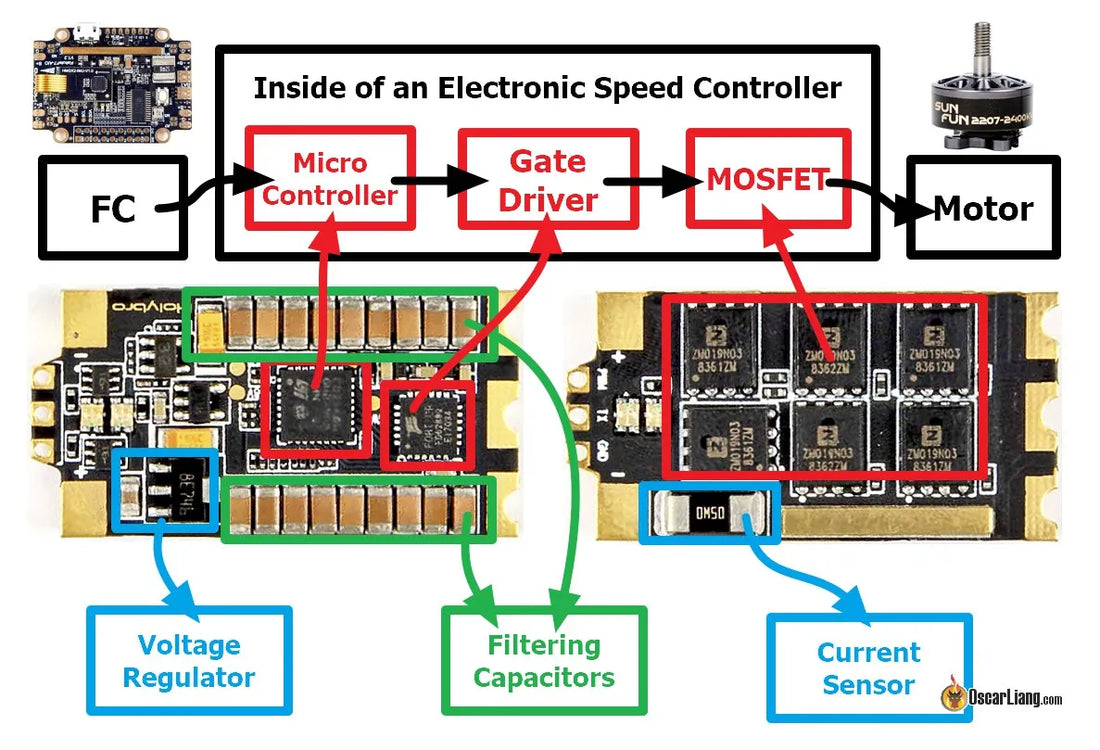
ESC Anatomy: Understanding the Components
ESC Anatomy: Understanding the Components
When it comes to electronic speed controllers (ESCs), understanding their anatomy and the function of each component can provide valuable insights into their operation. In this section, we will explore the essential components found in an ESC and their roles in controlling motor speed and ensuring efficient performance.

1. Microcontroller Unit (MCU):
The microcontroller, also known as the MCU or processor, serves as the brain of the ESC. It runs the ESC firmware and controls various functions, including receiving signals from the flight controller and generating the appropriate signals to drive the motor.
2. Gate Driver:
The gate driver is responsible for driving the MOSFETs (Metal-Oxide-Semiconductor Field-Effect Transistors) in the ESC. It connects to the gates of the MOSFETs, enabling precise control over their switching behavior. Modern ESCs often employ dedicated gate driver ICs, such as the FD6288, which contain multiple MOSFET gate drivers in a single chip.
3. MOSFET:
MOSFETs act as switches in the ESC circuitry, rapidly turning the motor power on and off. They handle the high current and voltage required to drive the motor. The size and quality of the MOSFETs directly impact the ESC's ability to handle power and withstand voltage spikes. Larger MOSFETs are generally associated with higher voltage and current capabilities, contributing to a more robust ESC.
4. Low Dropout Voltage Regulator (LDO):
The low dropout voltage regulator, or LDO, is responsible for converting the battery voltage to a stable and appropriate level to power the microcontroller and other components on the ESC board. It ensures a consistent power supply, even as the battery voltage fluctuates.
5. Current Sensor:
The current sensor measures the amount of current flowing through the ESC. This information is then sent to the flight controller, allowing real-time monitoring of the drone's current draw. It provides useful data for estimating battery capacity usage and helps prevent overloading the ESC and other components.
6. Filtering Capacitors:
Filtering capacitors are crucial for reducing electrical noise and stabilizing the voltage supplied to the ESC. They help minimize interference and maintain a clean power supply, enhancing overall ESC performance.
Understanding the role of each component in an ESC allows you to appreciate the intricacies of its design and functionality. From the microcontroller's control over motor speed to the MOSFETs' switching capabilities, these components work together to ensure smooth and efficient operation.
It's worth noting that advancements in ESC technology, such as integrated 4-in-1 ESCs, have enabled the integration of multiple ESCs onto a single PCB. This integration allows for a more compact and cost-effective solution, as shared components, such as the MCU and filtering capacitors, can be utilized across multiple ESCs.
By familiarizing yourself with the components and their functions, you can gain a deeper understanding of ESCs and make more informed decisions when selecting and optimizing them for your FPV drone.